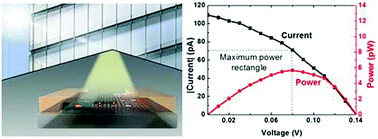A transparent solar cell based on a mechanically exfoliated GaTe and InGaZnO p–n heterojunction†
Abstract
Two-dimensional (2D) materials are known for their unique properties and potential for application in various electronic and optoelectronic devices. Since 2D semiconductors have weak bonding between the layers, they can be easily separated into several nanometer-thick layers which still maintain their characteristics. GaTe is a p-type 2D semiconductor having a direct bandgap. By combining multi-layer GaTe and thin-film IGZO, we have fabricated a p–n heterojunction, a fundamental unit of optoelectronic devices. In this paper, we propose the first fully transparent solar cell using a 2D material, based on a GaTe/IGZO heterostructure. The device shows a high transparency of ∼90% and an efficiency of 0.73% with a fill factor of 37%. It exhibits instantaneous generation of photo-carriers under periodic light pulses. Further analysis of the operating mechanism was conducted by studying its band alignments. The transparency of our GaTe/IGZO solar cell can overcome its relatively low efficiency, as it can be installed in a much larger scale and the total amount of generated power will surpass that of the conventional solar cell. Furthermore, advances in the large-scale growth of GaTe will enhance the power conversion efficiency, and finally enable the adoption of 2D active layer based highly transparent, thin-film solar cells for building integrated photovoltaic systems.



 Please wait while we load your content...
Please wait while we load your content...